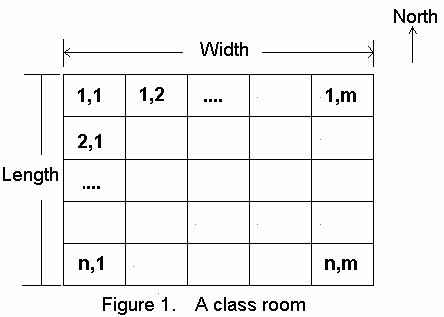Description
Students often have problems taking up seats. When two students want the same seat, a quarrel will probably begin. 



Input
There are several test cases and the input ended by a line of “0 0 0”. For each test case: The first line contains three integers: n , m and k ( 1 <= n,m<=30, 1<=k<=50). It means that there are n rows of seats in the classroom and there are m seats in every row. k is the number of students who come into the classroom trying to take up seats. Following are n lines describing the seats by north to south order .Each line represents a row of seats and contains m integers, indicating the “feeling index” of every seat in that row, by west to east order. “Feeling index” can be fit in a 32-bit integer. Then k lines follow (We call them k “student lines”). Each line is in the format of “hh:mm q” ( 0 <= hh < 24, 0 <=mm <= 59, 1<=q<=50 ) meaning that a student comes into the classroom at mm minutes past hh o’clock, trying to take up q seats. mm and hh are all two digit integers with possible leading zero, and q is also an integer. Please note that when a student enters the class room, he begins to do his seat taking job immediately and the job takes no time. It is guaranteed that the “feeling index” of every seat is different and no students come into the classroom at the same time.
Output
You should output k lines for each test case, in the order that correspondent to the above mentioned k “student lines” in the input. Each line must contain two integers indicating the coordinates of the seat which is saved by the student for himself. If the student can’t take up any seats, just output a “-1” instead.
题目大意:有n*m个座位,每个座位有一个权,每个学生来到之后会占座位,他占的座位一点在同一行而且连续,他一定会做在那排连续座位的最左边。在占到他想占的数量座位的前提下,他会找权值最大的座位来坐。如果不能帮别人占座位,他会自己选择一个权值最大的座位来坐而不帮朋友占座了。如果连自己的座位都没有,他会选择离开。现在有k个学生分别来占座,问他们占到的自己座位的坐标是什么,若离开了就输出-1.
思路:大水题,对每个学生的到达时间线排个序(不排会WA我试过了O(∩_∩)O),然后对每一个学生,先暴力枚举连续q个座位看能不能坐,能则选最大的,不能则再次暴力枚举空座位,选最大的,还是不能就只能滚粗了……最后按原来给的顺序输出答案即可。
代码(15MS):

1 #include <cstdio> 2 #include <algorithm> 3 #include <iostream> 4 #include <cstring> 5 using namespace std; 6 7 const int MAXN = 35; 8 const int MAXK = 55; 9 10 struct Node { 11 int id, t, q; 12 void read(int i) { 13 int hh, mm; 14 scanf("%d:%d %d", &hh, &mm, &q); 15 t = hh * 60 + mm; 16 id = i; 17 } 18 bool operator < (const Node &rhs) const { 19 return t < rhs.t; 20 } 21 }; 22 23 Node a[MAXK]; 24 int mat[MAXN][MAXN]; 25 bool use[MAXN][MAXN]; 26 int ans[MAXK][2], leave[MAXK]; 27 int n, m, k; 28 29 void init() { 30 memset(use, 0, sizeof(use)); 31 } 32 33 bool check(int x, int y, int l) { 34 for(int i = 0; i < l; ++i) 35 if(use[x][y + i]) return false; 36 return true; 37 } 38 39 void make_use(int x, int y, int l) { 40 for(int i = 0; i < l; ++i) 41 use[x][y + i] = true; 42 } 43 44 void solve() { 45 int max_comf, ans_i, ans_j; 46 bool flag; 47 for(int x = 1; x <= k; ++x) { 48 flag = false; 49 for(int i = 1; i <= n; ++i) { 50 for(int j = 1; j <= m - a[x].q + 1; ++j) { 51 if(!flag || mat[i][j] > max_comf) { 52 if(!check(i, j, a[x].q)) continue; 53 flag = true; 54 ans_i = i; ans_j = j; 55 max_comf = mat[i][j]; 56 } 57 } 58 } 59 if(flag) { 60 leave[a[x].id] = false; 61 ans[a[x].id][0] = ans_i; 62 ans[a[x].id][1] = ans_j; 63 make_use(ans_i, ans_j, a[x].q); 64 continue; 65 } 66 for(int i = 1; i <= n; ++i) { 67 for(int j = 1; j <= m; ++j) { 68 if(!flag || mat[i][j] > max_comf) { 69 if(use[i][j]) continue; 70 flag = true; 71 ans_i = i; ans_j = j; 72 max_comf = mat[i][j]; 73 } 74 } 75 } 76 if(flag) { 77 leave[a[x].id] = false; 78 ans[a[x].id][0] = ans_i; 79 ans[a[x].id][1] = ans_j; 80 use[ans_i][ans_j] = true; 81 continue; 82 } 83 else leave[a[x].id] = true; 84 } 85 } 86 87 int main() { 88 while(scanf("%d%d%d", &n, &m, &k) != EOF) { 89 if(n == 0 && m == 0 && k == 0) break; 90 for(int i = 1; i <= n; ++i) 91 for(int j = 1; j <= m; ++j) scanf("%d", &mat[i][j]); 92 for(int i = 1; i <= k; ++i) a[i].read(i); 93 sort(a + 1, a + k + 1); 94 init(); 95 solve(); 96 for(int i = 1; i <= k; ++i) { 97 if(leave[i]) puts("-1"); 98 else printf("%d %d ", ans[i][0], ans[i][1]); 99 } 100 } 101 }
